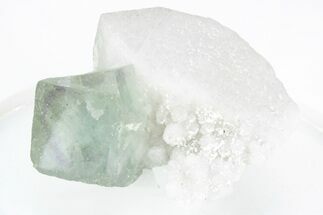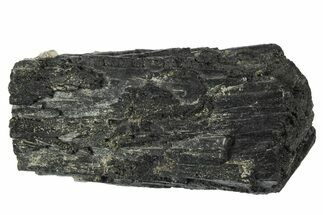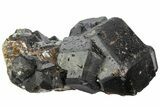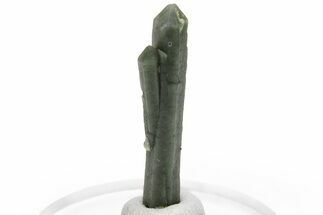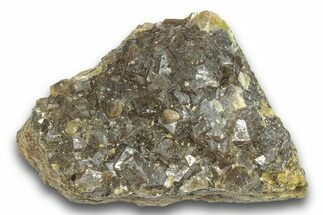This Specimen has been sold.
3.5" Andradite Garnets with Hedenbergite and Fluorapatite - China
This is a 3.5" wide cluster of, black, black andradite garnets (Melanite) (Melanite) that formed in association with small, light-green fluorapatite crystals and green hedenbergite, a combination of minerals that are seldom found together. It was collected from Chifeng City in Inner Mongolia, China.
It comes with an acrylic display stand.
It comes with an acrylic display stand.
Andradite is a species of the garnet group, and although not as well-known as some other types of garnets, such as Almandine or pyrope, it is the most lustrous. It tends to be opaque, so most andradite is not gemstone-quality. It occurs in skarns developed in contact-metamorphosed impure limestones or calcic igneous rocks; in chlorite schists and serpentinites; and in alkalic igneous rocks, often titaniferous.
Andradite comes in three varieties: melanite, colored by titanium substitutions for iron in its formula; topazolite, a rare and yellow-green variety; and demantoid, a striking green variety that is one of the world's rarest and most valuable gemstones.
Garnets are nesosilicates with the general formula X3Y2(SiO4)3. There are many species of garnet, including pyrope, almandine, spessartine, uvarovite, andradite, and grossular (varieties of which are hessonite, cinnamon-stone and tsavorite). Garnets are found in a wide variety of colors including red, orange, yellow, green, purple, brown, blue, black, pink, and colorless, though reddish shades are the most common.
Andradite comes in three varieties: melanite, colored by titanium substitutions for iron in its formula; topazolite, a rare and yellow-green variety; and demantoid, a striking green variety that is one of the world's rarest and most valuable gemstones.
Garnets are nesosilicates with the general formula X3Y2(SiO4)3. There are many species of garnet, including pyrope, almandine, spessartine, uvarovite, andradite, and grossular (varieties of which are hessonite, cinnamon-stone and tsavorite). Garnets are found in a wide variety of colors including red, orange, yellow, green, purple, brown, blue, black, pink, and colorless, though reddish shades are the most common.
Hedenbergite is a calcium iron (magnesium) silicate that often bears a range of green to brown coloration. The crystals are typically opaque and occur in stubby or prismatic aggregates. Inner Mongolia, Russia, and Greece all produce quartz crystals colored green by fibrous hedenbergite inclusions. A variety of hedenbergite can be found in Sweden as well: green-black, blocky crystals come from the Nordmark Odal Field in Värmland County.
Hedenbergite was given its name in 1819 by Jöns Jakob Berzelius, a Swedish chemist. He named the mineral in honor of Anders Ludvig Hedenberg, a chemistry student and co-worker who originally discovered and described the mineral in Tunaberg, Sweden.
The general chemical formula of Hedenbergite is CaFe2+Si2O6 .
Hedenbergite was given its name in 1819 by Jöns Jakob Berzelius, a Swedish chemist. He named the mineral in honor of Anders Ludvig Hedenberg, a chemistry student and co-worker who originally discovered and described the mineral in Tunaberg, Sweden.
The general chemical formula of Hedenbergite is CaFe2+Si2O6 .
Fluorapatite is the most common variety in the apatite group. It forms early in almost all igneous rock as small, microscopic crystals. It can display a wide variety of colors and can be confused with beryl, phenakite and milarite. Often forming bright, lustrous crystals with hexagonal faces and off-center terminations. They are found in vugs, often associated with quartz and calcite. Most complete crystals are around an inch in length, though larger crystals up to about 4 inches long have been found.
SPECIES
Andradite var Melanite, Hedenbergite & Fluorapatite
LOCATION
Hexigten Banner, Chifeng City, Inner Mongolia, China
SIZE
3.5 x 2.9"
CATEGORY
SUB CATEGORY
ITEM
#182842
 Reviews
Reviews
